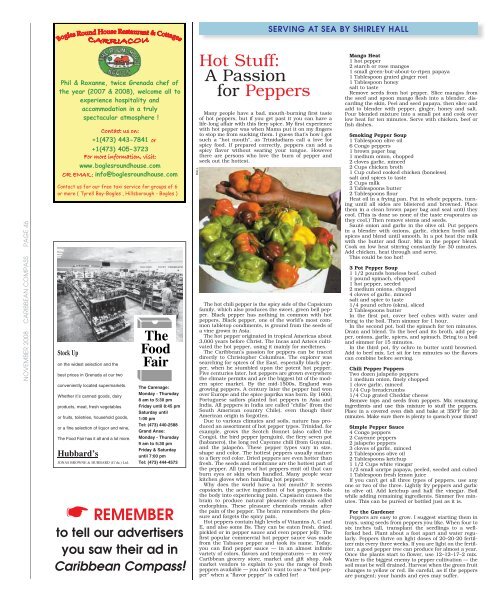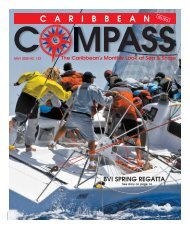A CRUISER'S VIEW OF BEQUIA - Caribbean Compass
A CRUISER'S VIEW OF BEQUIA - Caribbean Compass
A CRUISER'S VIEW OF BEQUIA - Caribbean Compass
You also want an ePaper? Increase the reach of your titles
YUMPU automatically turns print PDFs into web optimized ePapers that Google loves.
NOVEMBER 2008 CARIBBEAN COMPASS PAGE 46<br />
��������������������������������������<br />
���������������������������������������<br />
����������������������������<br />
�������������������������<br />
��������������������������<br />
��������������<br />
������������������<br />
��������������<br />
��������������<br />
�������������������������<br />
����� ����� �����<br />
��� ������� ���<br />
�����������������<br />
�����������������������������<br />
�����������������������������<br />
�����������������������������<br />
�����������������������������<br />
�������������������������<br />
����������<br />
������������������������������������<br />
����������<br />
����������<br />
�����������������������������������������������������<br />
������������������������������������������������������<br />
Stock Up<br />
on the widest selection and the<br />
best prices in Grenada at our two<br />
conveniently located supermarkets.<br />
Whether it’s canned goods, dairy<br />
products, meat, fresh vegetables<br />
or fruits, toiletries, household goods,<br />
or a fine selection of liquor and wine,<br />
The Food Fair has it all and a lot more.<br />
Hubbard’s<br />
JONAS BROWNE & HUBBARD (G’da.) Ltd.<br />
The Carenage:<br />
Monday - Thursday<br />
8 am to 5:30 pm<br />
Friday until 8:45 pm<br />
Saturday until<br />
1:00 pm<br />
Tel: (473) 440-2588<br />
Grand Anse:<br />
Monday - Thursday<br />
9 am to 5:30 pm<br />
Friday & Saturday<br />
until 7:00 pm<br />
Tel: (473) 444-4573<br />
☛ REMEMBER<br />
to tell our advertisers<br />
you saw their ad in<br />
<strong>Caribbean</strong> <strong>Compass</strong>!<br />
HALL<br />
Hot Stuff:<br />
A Passion<br />
for Peppers<br />
Many people have a bad, mouth-burning first taste<br />
of hot peppers, but if you get past it you can have a<br />
life-long affair with this fiery spice. My first experience<br />
with hot pepper was when Mama put it on my fingers<br />
to stop me from sucking them. I guess that’s how I got<br />
such a “hot mouth”, as Trinidadians call a love for<br />
spicy food. If prepared correctly, peppers can add a<br />
spicy flavor without searing your tongue. However<br />
there are persons who love the burn of pepper and<br />
seek out the hottest.<br />
The hot chili pepper is the spicy side of the Capsicum<br />
family, which also produces the sweet, green bell pepper.<br />
Black pepper has nothing in common with hot<br />
peppers. Black pepper, one of the world’s most common<br />
tabletop condiments, is ground from the seeds of<br />
a vine grown in Asia.<br />
The hot pepper originated in tropical Americas about<br />
3,000 years before Christ. The Incas and Aztecs cultivated<br />
the hot pepper, using it mainly for medicines.<br />
The <strong>Caribbean</strong>’s passion for peppers can be traced<br />
directly to Christopher Columbus. The explorer was<br />
searching for spices of the East, especially black pepper,<br />
when he stumbled upon the potent hot pepper.<br />
Five centuries later, hot peppers are grown everywhere<br />
the climate permits and are the biggest hit of the modern<br />
spice market. By the mid-1500s, England was<br />
growing peppers. A century later the pepper had won<br />
over Europe and the spice paprika was born. By 1600,<br />
Portuguese sailors planted hot peppers in Asia and<br />
India. All peppers in India are called “chilis” (from the<br />
South American country Chile), even though their<br />
American origin is forgotten.<br />
Due to various climates and soils, nature has produced<br />
an assortment of hot pepper types. Trinidad, for<br />
example, grows the Scotch Bonnet (also called the<br />
Congo), the bird pepper (penguin), the fiery seven pot<br />
(habanero), the long red Cayenne chili (from Guyana),<br />
and the jalapeño. These pepper types vary in size,<br />
shape and color. The hottest peppers usually mature<br />
to a fiery red color. Dried peppers are even hotter than<br />
fresh. The seeds and membrane are the hottest part of<br />
the pepper. All types of hot peppers emit oil that can<br />
burn eyes or skin when handled. Many people wear<br />
kitchen gloves when handling hot peppers.<br />
Why does the world have a hot mouth? It seems<br />
capsiacin, the active ingredient of hot peppers, fools<br />
the body into experiencing pain. Capsiacin causes the<br />
brain to produce natural pleasure chemicals called<br />
endorphins. These pleasure chemicals remain after<br />
the pain of the pepper. The brain remembers the pleasure<br />
and forgets the spicy pain.<br />
Hot peppers contain high levels of Vitamins A, C and<br />
E, and also some Bs. They can be eaten fresh, dried,<br />
pickled or in pepper sauce and even pepper jelly. The<br />
first popular commercial hot pepper sauce was made<br />
from the Tabasco pepper and took its name. Today,<br />
you can find pepper sauce — in an almost infinite<br />
variety of colors, flavors and temperatures — in every<br />
<strong>Caribbean</strong> grocery store, market and gift shop. Ask<br />
market vendors to explain to you the range of fresh<br />
peppers available — you don’t want to use a “bird pepper”<br />
when a “flavor pepper” is called for!<br />
SERVING AT SEA BY SHIRLEY HALL<br />
Mango Heat<br />
1 hot pepper<br />
2 starch or rose mangos<br />
1 small green-but-about-to-ripen papaya<br />
1 Tablespoon grated ginger root<br />
1 Tablespoon honey<br />
salt to taste<br />
Remove seeds from hot pepper. Slice mangos from<br />
the seed and spoon mango flesh into a blender, discarding<br />
the skin. Peel and seed papaya, then slice and<br />
add to blender with pepper, ginger, honey and salt.<br />
Pour blended mixture into a small pot and cook over<br />
low heat for ten minutes. Serve with chicken, beef or<br />
fish dishes.<br />
Smoking Pepper Soup<br />
1 Tablespoon olive oil<br />
6 Congo peppers<br />
1 brown paper bag<br />
1 medium onion, chopped<br />
2 cloves garlic, minced<br />
2 Cups chicken broth<br />
1 Cup cubed cooked chicken (boneless)<br />
salt and spices to taste<br />
2 Cups milk<br />
3 Tablespoons butter<br />
2 Tablespoons flour<br />
Heat oil in a frying pan. Put in whole peppers, turning<br />
until all sides are blistered and browned. Place<br />
them in a clean brown paper bag and seal until they<br />
cool. (This is done so none of the taste evaporates as<br />
they cool.) Then remove stems and seeds.<br />
Sauté onion and garlic in the olive oil. Put peppers<br />
in a blender with onions, garlic, chicken broth and<br />
spices and blend until smooth. In a pot heat the milk<br />
with the butter and flour. Mix in the pepper blend.<br />
Cook on low heat stirring constantly for 30 minutes.<br />
Add chicken, heat through and serve.<br />
This could be too hot!<br />
3 Pot Pepper Soup<br />
1 1/2 pounds boneless beef, cubed<br />
1 pound spinach, chopped<br />
1 hot pepper, seeded<br />
2 medium onions, chopped<br />
4 cloves of garlic, minced<br />
salt and spice to taste<br />
1/4 pound ochro (okra), sliced<br />
2 Tablespoons butter<br />
In the first pot, cover beef cubes with water and<br />
bring to the boil. Then simmer for 1 hour.<br />
In the second pot, boil the spinach for ten minutes.<br />
Drain and blend. To the beef and its broth, add pepper,<br />
onions, garlic, spices, and spinach. Bring to a boil<br />
and simmer for 15 minutes.<br />
In the third pot, fry ochro in butter until browned.<br />
Add to beef mix. Let sit for ten minutes so the flavors<br />
can combine before serving.<br />
Chili Pepper Poppers<br />
Two dozen jalapeño peppers<br />
1 medium onion, finely chopped<br />
1 clove garlic, minced<br />
1/4 Cup breadcrumbs<br />
1/4 Cup grated Cheddar cheese<br />
Remove tops and seeds from peppers. Mix remaining<br />
ingredients and use this mixture to stuff the peppers.<br />
Place in a covered oven dish and bake at 350°F for 20<br />
minutes. Make sure there is plenty to quench your thirst!<br />
Simple Pepper Sauce<br />
4 Congo peppers<br />
2 Cayenne peppers<br />
2 jalapeño peppers<br />
3 cloves of garlic, minced<br />
2 Tablespoons olive oil<br />
2 Tablespoons ketchup<br />
1 1/2 Cups white vinegar<br />
1/2 small unripe papaya, peeled, seeded and cubed<br />
1 Tablespoon fresh lemon juice<br />
If you can’t get all three types of peppers, use any<br />
one or two of the three. Lightly fry peppers and garlic<br />
in olive oil. Add ketchup and half the vinegar. Boil<br />
while adding remaining ingredients. Simmer five minutes.<br />
This can be puréed or bottled just as it is.<br />
For the Gardener<br />
Peppers are easy to grow. I suggest starting them in<br />
trays, using seeds from peppers you like. When four to<br />
six inches tall, transplant the seedlings to a wellforked<br />
bed. Plant about a foot apart and water regularly.<br />
Peppers thrive on light doses of 20–20-20 fertilizer<br />
mix every three weeks. If you are light on the fertilizer,<br />
a good pepper tree can produce for almost a year.<br />
Once the plants start to flower, use 12–12–17–2 mix.<br />
Water is the biggest enemy to pepper cultivation — the<br />
soil must be well drained. Harvest when the green fruit<br />
changes to yellow or red. Be careful, as if the peppers<br />
are pungent; your hands and eyes may suffer.

















